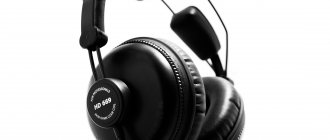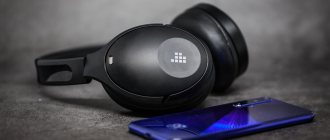This article is taken from PersonalAudio
I posted this here for a video about Apple AirPods 2, so as not to constantly search))
Video: https://www.youtube.com/watch?v=nQ1SRf0-118
Amplitude-frequency characteristic - the dependence of the signal amplitude on frequency (abbreviated as frequency response, in English - frequency response). The amplitude-frequency response graph shows the frequency loudness balance and the sensitivity of the headphones when plotted in absolute terms. If we reproduce the sine of a specific frequency by feeding it at a level of 1 V rms and record the pressure level at the headphone output in a special chamber emulating an ear, then by going through the frequencies from 20 Hz to 20 kHz, we will get the original frequency response graph to 1 V rms. Often headphones are measured at an arbitrary volume level, which makes it impossible to calculate sensitivity, but allows the frequency response to be obtained relative to an arbitrarily chosen reference value, assigning a 0 dB value to the frequency at 1000 Hz. Using this graph, it is impossible to determine the ability to “play loud” of headphones, but it is possible to assess the balance of frequencies, which range is dominant, and which, on the contrary, is muted.
↑ Chinese patient Axelvox HD241
The Axelvox HD241 are popular and beloved headphones, but their sound is not without its shortcomings.
Actually, sound is a subjective question, but objectively there is a frequency response, and it is crooked. There is an excess of high frequencies. It would seem that for a modern listener, who plays most of the audio content from a computer, this is not a problem. Turn the equalizer as you like, business... In practice, this turns out to be inconvenient: every time we switch from headphones to (fairly smooth) speakers, we have to turn off the equalizer manually. The system is not smart enough to have different equalizers for different outputs.
Looking at this sad situation, I decided to close the issue once and for all. If they make passive filters for speakers, why can't they do something similar for headphones? Well... actually they do. There are multi-driver armature headphones, in which the bands are, of course, filtered:
Crossover inside Westone W3 multi-driver headphones
As you can see, this can be done quite compactly. In full-size headphones there are no such strict restrictions on dimensions, so we have some freedom of action in terms of choosing certain solutions.
For analysis, initial data is needed. You can find the frequency response and impedance graph of the headphones on personalaudio.ru. People have gone to the trouble and made careful measurements of several hundred headphones, including ours. True, the database has not been updated since 2014, it can still be useful.
What do we see here? Ahhhh, nightmare!
The top really dominate! Starting from kilohertz, the frequency response gradually increases and by 8 kilohertz it exceeds the shelf by 10-12 dB. This cannot be tolerated!
Practice - real results
Examples
Smooth frequency response, recognized in studios for full-size headphones
More unevenness can be observed in the upper mids and lower highs.
Smooth frequency response, recognized in home systems for full-size headphones
Here the frequency response is close to direct and there are no complaints from listeners about the subjective increase in the range in region 3. How do the opinions obtained in studios and home systems reconcile, where the alternative is high-end speaker systems with fairly flat frequency response? The fact is that in the studio the headphones are listened to at high volume, and at home at low volume. Based on the curves of equal loudness, at higher volumes, the region around 3 kHz is perceived louder, so when choosing headphones, you need to take into account the volume at which they will be listened to.
Smooth frequency response for in-ear headphones with high noise insulation in the low frequency region
Thanks to good noise insulation, at low volume the headphones can reproduce the entire spectrum of frequencies and artificial dips and rises in the frequency response are not required.
Preferred frequency response for in-ear headphones with low noise insulation in the low frequency region.
In the subway and other transport, the low-frequency hum is high enough to drown out the low-frequency component in a musical composition. For this reason, bass models are more popular and are perceived as smooth. The parameters sometimes indicate the level of noise insulation, but, as a rule, in the mid and high frequency range.
↑ Assembly
Finally, we are assembling the layout.
Small ferrite “dumbbells” were used to wind the coils. Not that it was a very conscious choice, it was just like that. Still, the size turned out to be successful. The 0.25 mm PEV wire filled the window almost completely, and the DC resistance was only 3 Ohms, which can be considered an acceptable result. You should not try to make the coils ultra-compact: this way you can achieve that the ferrite will be saturated even at a very low current. For quick winding, it is convenient to clamp the dumbbell into a screwdriver. I measured my coils with a digital tester “Victor VC9808+”, I want to praise it - it can do a lot, TrueRMS, among other things, the usual measures frequency, capacitance, inductance, the cost is acceptable, I’ve been using it constantly for five years.
Improve headphone sound on Windows 10 computers
In Windows, there is a huge amount of software that supports equalizer presets: EqualizerAPO, Peace and many players such as Neutron, Roon and Foobar2000. To improve the sound of headphones on a computer in all programs, we will use the free EqualizerAPO.
The program is distributed free of charge, you can download the installation file from the official website equalizerapo.com. The installer will ask you to select a folder to install the program; you must remember it.
Then you need to finish the installation and reboot the computer. To download an equalizer preset, go to GitHub of the AutoEq project and use search (ctrl+f) to find your headphone model.
Select it, then click on the file called *headphone model*ParametricEQ.txt.
To download the file from GitHub, click “Raw” as shown in the screenshot below.
Right-click and click “Save As...”
Save the file in the C:\Program Files\EqualizerAPO\config\ folder with the name config.txt and agree to the replacement. After this, the equalizer settings will change.
↑ Conclusions
Indeed, the sound has changed.
A smoother frequency response gives a quieter presentation of sound material. No distortion or other unpleasant manifestations are heard. One gets the impression that the manufacturer deliberately raised the highs to add pseudo-details to the sound. In fact, it just makes you tired. Subjectively, the headphones began to be perceived as quieter. To achieve a comfortable volume, we had to almost double the input signal power. Previously, with the volume knob in this position, it hurt my ears. But this effect is completely expected, because... All passive filters always introduce attenuation into the signal.
I like the current smooth delivery much better. Great, let's leave it like that. All that remains is to place the corrector inside the ears. Although no, I won’t do that yet, I’ll play around with R2 a little. Everything turned out to be quite easy. But I’ve had these headphones for several years now; all this could have been done at once.
Comrades, now the frequency response of the headphones is in our hands!
Thank you for your attention!
Theory
Ideally, the frequency response should be direct when the source is an acoustic system, such as computer speakers, home theater speakers or studio monitors. The location of the headphones relative to our ears is completely different; they are not located at 60 degrees relative to the axis of the ear, but without deviation at 0 degrees. Try an experiment and listen to the speakers in an equilateral triangle and on an axis. The sound will differ noticeably not only in the construction of the stage, but also in the perception of different frequency ranges. All this is the influence of the structure of the auricle and auditory canal. The on-axis speakers will become “brighter” in the high-frequency region and sound different in the mid-frequency region.
Headphones are not only located on the axis, they are located next to the ear, or even inserted into the ear canal (in the case of “plugs”). All this significantly affects the perception of the frequency range and for each person individually
Ideal frequency response from speakers
The ideal frequency response from a speaker is a straight line, indicating that all frequencies are reproduced equally loudly.
If the headphone speaker is placed in the ear near the eardrum, then the frequency response that corresponds to the red or yellow line will be perceived as smooth. It is precisely this frequency response of headphones that is subjectively “direct”. Unfortunately, you cannot completely rely on them, because... Each person has their own ear structure and, accordingly, there is a wide range of deviations from the “ideal”. Another point is that the location of the sources near the ear gives a different psychological perception of the frequency response than when listening to sources at a remote distance. In this regard, some publications, after measurements, make a “universal” correction for the measured frequency response (correction for their measuring equipment), but as a rule there is no great benefit from this. In the case of headphones, one can only draw general conclusions. By the way, the location of the microphone in the dummy’s ear can be either at the location of the eardrum or at the entrance to the ear canal (for measurements of full-size and on-ear headphones). Scientists have not yet reliably determined what gives a more adequate result. Our laboratory uses a mannequin with a microphone located at the entrance to the ear canal. The second factor that reduces the usefulness of the compensation curve is the different perception of the frequency response depending on the volume level. As a result, for quiet listening the dip in the upper mids and lower treble should be minimal, but for loud playback the dip should be significant.
Examples
Over-ear headphones
If the graph shows dips in the region of 2-5 kHz, then these headphones can provide good compensation towards the perception of a flat frequency response. The roll-off at high frequencies compensates for the location of the headphones on the axis of the ear.
Lilac – conditionally ideally flat frequency response. The red graph shows the rise of low frequencies - these headphones are bassy. Green – on the contrary, a decrease in low frequencies; this sound is closer to the sound of speaker systems, where there is a natural roll-off in the low frequency region (in systems without a powerful subwoofer). Orange – headphones with possible sibilance, emphasizing the “sss” sounds. Blue – rise in the high frequency region.
On-ear headphones
In over-ear headphone measurements, a roll-off can be observed in the low-frequency region. This may be caused by the use of foam ear pads or a loose fit to the ears. When any air gap occurs, the low frequency level is reduced. In this case, measuring through a special flat stand, with a softness that replicates human skin (in our case Soft Flat Stand - SFS), helps to assess the bass level.
In-ear headphones
In-ear headphones are inserted directly into the ear canal, and those that have minimal dips in the upper mids and lower trebles, and a fairly significant dip in the highs, will be perceived as smooth. For in-ear headphones, the roll-off in the high-frequency region should be even higher than that of full-size headphones, because there are fewer obstacles responsible for the natural reduction of the high-frequency range. The green and lilac graphs refer to “flat frequency response”, their difference is in the different dip in the level of the upper middle and lower high frequencies, where the sensitivity of the ear is maximum. The larger the dip, the higher the volume the headphones will be perceived as smooth, and vice versa, the smaller the dip, the lower the volume the sound will be subjectively smooth. The red graph shows headphones with bass, and the blue graph shows bright headphones in the high frequencies.
Resonances
On the graphs of in-ear headphones, you can see peaks in the high frequency region; as a rule, these are resonances that arise in the closed space of the sound guide and ear canal. Resonance frequencies depend on the seating depth of the earphone and the shape of the ear canal. On-ear and full-size headphones have much more resonances, but they have smaller amplitudes and are thus reflected in the frequency response as a slight unevenness. In over-ear and full-size headphones, resonances are formed mainly by reflections in the auricle and often create three-dimensional sound.










